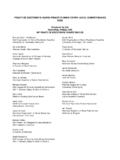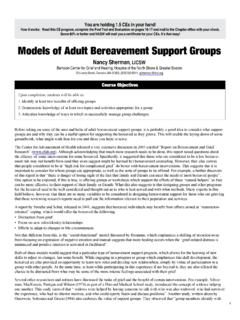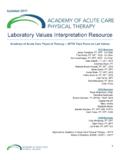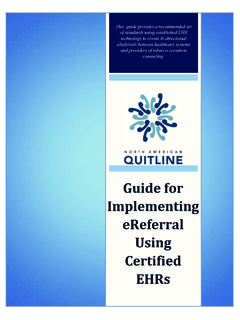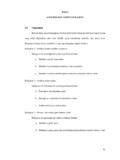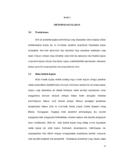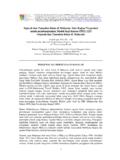Transcription of BALTIMORE Baltimore - c.ymcdn.com
1 2018 BALTIMOREB altimorehilton hotelFebruary 21-24 RAPID RESPONSEABSTRACTSThe peer-review process for SRNT s annual meeting entails review by society members of abstract submissions. Criteria for acceptance/rejection are based upon methodological rigor and not the funding source or research findings. The views expressed by conference presenters are the authors own and do not necessarily represent that of Session 5 Saturday, February 24 2018 12:15 :30 SESSION 5 POS5-1 FACTORS RELATING TO ABSTINENCE SELF-EFFICACY AND MOTIVATION TO QUIT AMONG SMOKERS WITH SUBSTANCE USE DISORDERSH annah Brinkman*1, Haruka Minami2, Erika Litvin Bloom3,4, Jacki Hecht5, Ana Abrantes4,6, Christopher Kahler7, Richard Brown5, 1 Icahn School of Medicine at Mount Sinai, NY, 2 Fordham University, NY, 3 Rhode Island Hospital, RI, 4 Alpert Medical School of Brown University, RI, 5 University of Texas at Austin, TX, 6 Butler Hospital, RI, 7 Brown University School of Public Health, RICigarette smoking rates among individuals with substance use disorders (SUDs)
2 Remains substantially higher than the general population. Understanding the fac-tors associated with readiness to quit and abstinence self-efficacy may help to shape interventions that increase quit attempts and cessation amongst this at-risk population. This study examined whether readiness to quit and abstinence self-ef-ficacy in three different contexts ( , negative affect, social/positive, habit/craving) were related to perceived stress, negative consequences related to substance use, and belief that quitting smoking will harm one s recovery among smokers with SUDs. Baseline data from a clinical trial examining an intervention designed to engage smokers in quitline use with 60 adult smokers in a SUD day treatment program, recruited irrespective of motivation to quit smoking, were used.
3 A total of 19 (32%) participants reported that they were ready to quit smoking in the next 30 days. Analyses, controlling for age, gender, and nicotine dependence, showed that neither perceived stress nor problems related to substance use were related to readiness to quit within the next 30 days or abstinence self-efficacy in any of the three situations. The belief that quitting smoking will hurt one s sobriety was negatively associated with readiness to quit on both binary (yes/no) (OR = , 95%CI: , p = .003) and continuous measures (1-10 scale) ( = , SE = , p < .001). Those more likely to endorse this belief also reported reduced abstinence self-efficacy, but only in situations relating to habit/craving ( = , SE = , p =.)
4 015). In sum, one third of smokers currently receiving substance use treatment were ready to quit smoking regardless of perceived stress or sever-ity of substance use problems. On the other hand, belief that smoking cessation would interfere with their recovery effort may interfere with readiness to quit and confidence in their ability to stay quit in certain contexts. Development and eval-uation of interventions that address the perception that quitting will harm one s sobriety may be needed. FUNDING: FederalCORRESPONDING AUTHOR: Hannah Brinkman, Icahn School of Medicine at Mount Sinai, NY, USA, SUPPORT FOR TOBACCO CONTROL IN GERMANY: RESULTS FROM THE GERMAN STUDY ON TOBACCO USE (DEBRA STUDY)Melanie B ckmann*1, Daniel Kotz1, Diana Lubisch1, Lion Shahab2, Jamie Brown2, Sabrina Kastaun1, 1 Medical Faculty of the Heinrich-Heine-University, Germany, 2 University College London, United KingdomSIGNIFICANCE: Germany has ratified the World Health Organization Framework Convention on Tobacco Control with the aim of decreasing prevalence of tobacco smoking.
5 In Germany, smoking prevalence is still high (27%), and implementation of tobacco control needs to be improved. Whether the German population would support stricter tobacco legislation is not yet fully known. This presentation reports findings on public support for such measures from a representative survey on tobacco use in Germany. METHODS: We analyzed data on public support gen-erated as part of the German Study on Tobacco Use (DEBRA study). Data from 2,062 participants aged 14 years and older were collected through a face-to-face household survey in September 2016. To be representative of the German popula-tion all data were weighted. Public support for tobacco control was measured with five questions: whether participants would agree to a total ban on sale of tobacco, taxation of tobacco industry sales, research on e-cigarettes as smoking cessa-tion aid, raising the legal age for tobacco sales, and legislation to ban smoking in car while minors are present.
6 Associations between sample characteristics and support of policy measures were assessed with multivariate logistic regression analyses using unweighted data. RESULTS: The majority of the study population ( ; 95%CI= ), would support a smoking ban in cars when mi-nors are present, even among current smokers ( , 95%CI= ). Over 50% of the population would support taxation of tobacco industry sales ( , 95%CI= ) and extended research on e-cigarettes ( , 95%CI= ). Over 40 % of the population expressed agreement with raising the legal age for tobacco sales from 18 to 21 ( , 95%CI= ), and would support a total ban on tobacco sales (95%CI= ).
7 Non-smokers and ex-smokers agreed significantly more often with the proposed policy changes than current smokers. CONCLUSIONS: Stricter tobacco control policy is likely to be supported by the German population, with implemen-tation of a total ban of smoking in cars when minors are present being the most accepted measure even among : FederalCORRESPONDING AUTHOR: Melanie B ckmann, Medical Faculty of the Hein-rich-Heine-University, Germany, BARRIERS AND FACILITATORS TO SMOKING CESSATION AMONG CENTRAL AND EASTERN EUROPEAN NURSES: A FOCUS GROUP STUDYMary Rezk-Hanna*1, Linda Sarna1, Anne Petersen2, Marjorie Wells1, Iveta Nohavova3, Stella Bialous4, 1 University of California, Los Angeles, CA, 2 Loma Linda University, CA, 3 Society for Treatment of Tobacco Dependence, Czech Republic, 4 University of California, San Francisco, CASIGNIFICANCE: Smoking among nurses is a barrier to providing smoking cessa-tion interventions to patients.
8 In Central and Eastern Europe where tobacco use is the leading cause of preventable death and disease there is limited knowledge about nurses attitudes toward cessation interventions. Our aim was to explore the attitudes of nurses who are former and current smokers toward providing ces-sation interventions to patients as well as barriers and facilitators to their own quit efforts. METHODS: Nine focus groups with 81 nurses (94% females) in five Central and Eastern European countries. Content analysis was used to identify major themes. RESULTS: Nurses agreed that they should set a good example by not smoking; should be involved in helping patients stop smoking; and needed additional training in tobacco control.
9 Five common themes were identified as bar-riers to quitting: smoking cues in the environment; presence of smokers in the en-vironment; relapse postpartum; stress and nicotine addiction; and misperceptions about the dangers of smoking. Former smokers reported facilitators to quitting including: seeing the health consequences of smoking among their patients; per-sonal and family health concerns; receiving support from family; and pregnancy. CONCLUSIONS: There is a need to build upon nurses positive attitudes about engaging in smoking cessation interventions with patients to ensure that cessa-tion interventions are standard nursing practice.
10 Future studies should focus on programs that support nurses quit efforts by addressing barriers to smoking ces-sation, which will improve their health and patient : Academic Institution; FederalCORRESPONDING AUTHOR: Mary Rezk-Hanna, University of California, Los Angeles, CA, USA, DEVELOPMENT AND VALIDATION OF A CONTEXTUAL BEHAVIORAL DISTRESS INTOLERANCE TASK IN SMOKERSS amantha Farris*1, Angelo DiBello2, Michael Zvolensky3, 1 Alpert Medical School of Brown University, RI, 2 Brown University School of Public Health, RI, 3 University of Houston, TXSIGNIFICANCE: Distress intolerance (DI) reflects an individual s perceived or ac-tual inability to withstand negative emotional or physical states.





